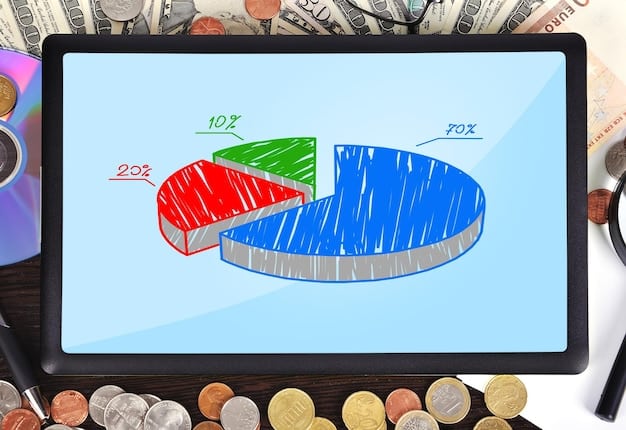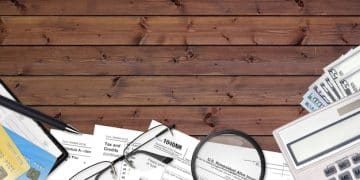How to Build a $10,000 Emergency Fund in 12 Months

Building an emergency fund of $10,000 in 12 months involves setting a clear savings goal, creating a detailed budget, automating savings, increasing income streams, and making disciplined financial decisions.
Facing financial uncertainty can be daunting. But what if you could build a safety net of $10,000 in just 12 months? This step-by-step guide on how to build an emergency fund of $10,000 in 12 months provides actionable strategies to take control of your financial future and achieve your savings goal.
Why Building an Emergency Fund Is Crucial
An emergency fund acts as a financial shield, protecting you from unexpected expenses that could derail your financial stability. It provides peace of mind, knowing you have resources to handle life’s curveballs without resorting to debt.
Avoiding Debt
Without an emergency fund, unexpected costs often lead to credit card debt or loans, which can accrue high interest. The guide on how to build an emergency fund of $10,000 in 12 months helps avoid this cycle.
Peace of Mind
Knowing you can cover emergencies reduces stress and anxiety. This financial security allows you to focus on your goals and enjoy life without constant worry.
- Financial security during job loss.
- Handles unexpected medical bills.
- Covers car repairs or home emergencies.
- Enables seizing unexpected opportunities.
An emergency fund is not just about money; it’s about security and peace of mind. It empowers informed decisions and provides stability when needed most.

Step 1: Assess Your Current Financial Situation
The first step in how to build an emergency fund of $10,000 in 12 months is understanding your current financial standing. To do this, take a close look at your income, expenses, debts, and assets to create a clear financial picture.
Calculate Your Net Worth
Determine your net worth by subtracting your liabilities (debts) from your assets (savings, investments, property). This figure gives you a baseline to measure your progress.
Track Your Spending
Monitor where your money goes for a month to identify spending habits. This can be done manually using a notebook or with budgeting apps that automatically categorize transactions.
- List all sources of income (salary, side hustles).
- Detail all fixed expenses (rent, insurance).
- Identify variable expenses (groceries, entertainment).
- Calculate discretionary spending (dining out, hobbies).
Assessing your financial situation provides the foundation for setting realistic savings goals and identifying areas where you can cut back and save. By understanding where your money goes, you can make informed decisions and create a budget that prioritizes your emergency fund.
Step 2: Set a Realistic Savings Goal
Setting a savings goal is essential when discussing how to build an emergency fund of $10,000 in 12 months. This target, broken into smaller, manageable milestones, makes the overall objective feel less daunting.
Calculate Monthly Savings Needed
To save $10,000 in 12 months, you need to save approximately $833.33 per month. Break this down further into weekly amounts to make it even less overwhelming.
Automate Your Savings
Set up automatic transfers from your checking account to a dedicated savings account for your emergency fund. This ensures consistent savings without relying on willpower.

- Calculate weekly and monthly savings targets.
- Set up automatic transfers to a savings account.
- Choose a high-yield savings account.
- Adjust savings based on income fluctuations.
Realistic savings goals are vital for staying motivated. Adjust the amount depending on your income and expenses, but aim for consistency. Automating the savings process eases the burden and increases the likelihood of hitting your targets, bringing you closer to financial security.
Step 3: Create a Detailed Budget
Budgeting involves planning how your money will be spent each month. It is a key strategy when discussing how to build an emergency fund of $10,000 in 12 months, allowing for informed choices and control over your finances.
Prioritize Essential Expenses
Begin by listing essential expenses such as rent, utilities, groceries, and transportation. Ensure these needs are covered before allocating funds to other categories.
Identify Areas to Cut Back
Once essential expenses are covered, look for areas where you can reduce spending. Consider cutting back on dining out, entertainment, or subscriptions.
- Use budgeting apps to track spending.
- Set spending limits for discretionary expenses.
- Review your budget regularly.
- Adjust budget as income or expenses change.
Creating a budget isn’t about deprivation; it’s about making conscious decisions about where your money goes. Regular reviews and adjustments ensure the budget remains effective, supporting consistent progress toward your savings goal. This control is essential for long-term financial success.
Step 4: Increase Your Income Streams
Increasing income can significantly speed up how to build an emergency fund of $10,000 in 12 months. Additional income beyond your primary job provides extra funds that can be dedicated to savings.
Consider a Side Hustle
Explore side hustles such as freelancing, delivery services, or online tutoring. These can offer flexible hours and additional income.
Monetize Your Skills
Use your skills and hobbies to generate income. For example, offer photography services, create and sell crafts, or provide consulting in your area of expertise.
- Identify skills and interests.
- Explore online freelancing platforms.
- Set achievable income goals.
- Reinvest earnings into savings.
Adding income streams requires time and effort but can greatly accelerate savings. Whether it’s a part-time job or monetizing a hobby, additional income provides a financial cushion, making it easier to reach your goal. Diversifying income also provides security in case of job loss or reduced hours.
Step 5: Make Disciplined Financial Decisions
Discipline is crucial when approaching how to build an emergency fund of $10,000 in 12 months. Making careful financial choices and resisting impulsive spending are key to staying on track.
Avoid Impulse Purchases
Before making a purchase, especially a significant one, take time to consider whether it aligns with your financial goals. Avoid shopping when emotional or bored.
Delay Gratification
Postpone non-essential purchases and redirect those funds into your emergency fund. Delaying gratification can make a substantial difference in savings over time.
- Create a waiting period for non-essential purchases.
- Use cash instead of credit cards.
- Set financial boundaries with friends and family.
- Celebrate savings milestones to stay motivated.
Discipline in financial decisions is the bedrock of any successful savings plan. When temptations arise, remember the importance of your emergency fund and the security it provides. Small, consistent choices compound over time, bringing you closer to your goal of $10,000 saved.
| Key Point | Brief Description |
|---|---|
| 🎯 Set Clear Goals | Aim to save $833.33 monthly ($10,000 in 12 months). |
| 💸 Budget Wisely | Track expenses and cut unnecessary spending. |
| 🚀 Increase Income | Explore side hustles or skills monetization. |
| 🏦 Automate Savings | Schedule recurring transfers to savings account. |
FAQ
▼
An emergency fund provides a financial safety net to cover unexpected expenses such as medical bills, job loss, or car repairs, preventing you from incurring debt.
▼
To save $10,000 in 12 months, you should aim to save approximately $833.33 per month. Breaking this down into weekly targets can make it feel more manageable.
▼
A high-yield savings account (HYSA) is ideal for an emergency fund because it offers higher interest rates compared to traditional savings accounts, helping your money grow faster.
▼
You can increase your income by taking on a side hustle, such as freelancing, delivery services, or online tutoring, or by monetizing a skill or hobby you have.
▼
Common pitfalls include impulse purchases, not tracking your expenses, and not having a budget. Avoiding these behaviors will help you stay on track and reach your savings goal.
Conclusion
Building a $10,000 emergency fund in 12 months is achievable with a structured approach, discipline, and commitment. By assessing your finances, setting realistic goals, budgeting effectively, increasing income, and making sound financial decisions, you can create a secure financial foundation for the future.





